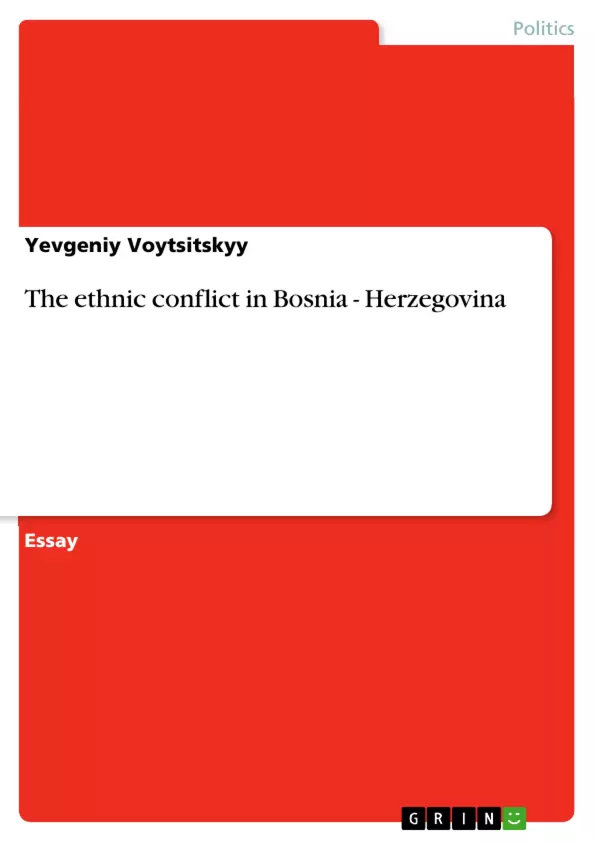Each conflikt has a source, a beginning. This beginning usually is a different point of view or a different ideology of the opposing parties. At best, these conflicts come about as protest and demonstrations and are solved by compromise, by agreements or by mutual concessions. If the opposing parties cannot solve the conflict by these means, the elimination, the abolition or the destruction of the opposing group often becomes a sad reality of our world. In the worst case a war begins. If a conflict is ended by one side winning over the other by struggle or war, we may not call it a “solution.” The concept of “solution” or better “conflict resolution” is generally associated with the purposeful searching for ways of accomodating the differing interests of the opposing groups. This does not necessarily mean, that the sources of the conflict are eliminated, but that “live and let live” policy (Williams, 1947) is the framework of the further peaceful interaction of the former opposing parties.
Inhaltsverzeichnis (Table of Contents)
- Each conflict has a source, a beginning
- The existing "state", Bosnia, being a part of Yugoslavia
- Agreement or compromise became nearly impossible now
- At this state of affairs the international community attempted to intervene, but failed
- Then another intervention by "Brussels" leaded to more violence and struggle
- As I have already mentioned, conflicts are solved by compromise or by agreement
- Only few members of the international community critisized the decision taken by "Brussels"
- When in the later course of the war in Bosnia, the surrounding Europe asked the UN to send troups, the UN was still offended and refused
- Isn't it a kind of "kindergarden" to react so offended, even if the other party (in this case "Brussels") had acted stupidly?
- Anyway, the UN sent Barrack Goulding to find out more about the war in Bosnia
- In the following time the civil population in Bosnia suffered terribly and also the neighbouring countries were forced to react as they lay so near
- Although the European Community had taken wrong decisions in the past, it was asked again to mediate in Bosnia
- In the concept of the European Community the responsabilities followed a rotating system
- Surely it was very difficult to divide the country into three equal parts, but it would have been possible
- Questions arise: Is this really democratic?
- Only in 1995 the peace contract of Dayton as a result of long and difficult negotiation brought an end to the terrible war in Bosnia
- Each conflict has a source. Agreement and compromise are the major means for conflict resolution
Zielsetzung und Themenschwerpunkte (Objectives and Key Themes)
The text explores the ethnic conflict in Bosnia-Herzegovina, examining the historical context, the dynamics of the conflict, and the role of the international community in its escalation and attempted resolutions. It aims to understand how the conflict evolved, identify the contributing factors, and analyze the effectiveness of international intervention.
- The historical context of the conflict in Bosnia-Herzegovina
- The role of international intervention in exacerbating the conflict
- The failure of attempts at compromise and peaceful resolution
- The impact of the conflict on the civilian population
- The contrast between the ideal of "conflict resolution" and the reality of the situation
Zusammenfassung der Kapitel (Chapter Summaries)
The text begins by outlining the general dynamics of conflicts, emphasizing the importance of compromise and agreement for peaceful resolution. It then delves into the historical context of the conflict in Bosnia-Herzegovina, examining the tensions between the different ethnic groups within the former Yugoslavia. The text highlights the breakdown of the existing government and the subsequent attempts at achieving independence, which led to further conflict and escalation.
The text then focuses on the role of the international community, primarily the European Community and the United Nations, in the conflict. It analyzes the various interventions, including attempts at mediation and peace enforcement, and argues that these efforts often contributed to the escalation of violence rather than resolving the conflict. The text concludes by examining the various initiatives for peaceful resolution, including the Dayton Agreement, and ultimately highlighting the challenges and complexities of conflict resolution in Bosnia-Herzegovina.
Schlüsselwörter (Keywords)
The main keywords and focus topics of the text include ethnic conflict, Bosnia-Herzegovina, Yugoslavia, international intervention, conflict resolution, compromise, agreement, peace enforcement, Dayton Agreement, and historical context. The text explores the dynamics of the conflict, analyzing the role of different actors, the failure of mediation attempts, and the lasting impact of the conflict on the region.
- Quote paper
- Bachelor of Arts in Social Science / European Studies Yevgeniy Voytsitskyy (Author), 2008, The ethnic conflict in Bosnia - Herzegovina, Munich, GRIN Verlag, https://www.grin.com/document/161882



